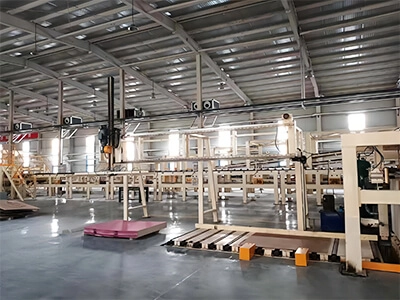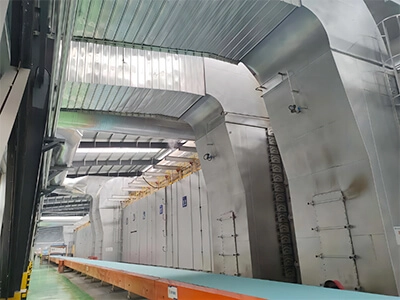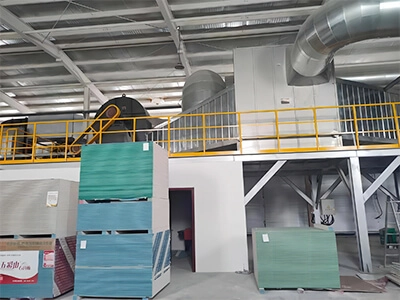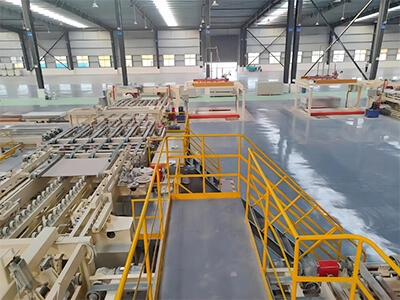
Gypsum Board Machine Factory

Paper Faced Gypsum Board Machinery

Produce Gypsum Board

Paper Faced Gypsum Board Production Line
Alpha gypsum powder is produced under high pressure and temperature in autoclave. It is widely used in dental mold, ceramic mold, sculpture, and etc.
The alpha Gypsum powder production line is composed of autoclave, grinding machine,elevator packing machine and etc.
Alpha process
Alpha gypsum plaster process
The basic Alpha process of making high strength gypsum powder is: gypsum rock -- crusher - autoclave-- grinder -- silo-- packing machine
gypsum powder production line capacity 5,000 tons per year10,000 tons per year
Features of the Alpha Machine and alpha equipment
The autoclave system is the key procedure of Alpha Machine and Alpha equipment. The gypsum inside the autoclave is under high pressure and temperature. High strength of gypsum is thus formed.
The condition for forming α gypsum is to remove 1.5 water molecules from the dihydrate gypsum in pure saturated steam or in a certain temperature and pressure aqueous solution, and discharge them as liquid water. Then, the hemihydrate gypsum dissolves in it to reach supersaturation, and forms hemihydrate gypsum crystals through nucleation or seed formation.
The production Alpha process characteristics of type α gypsum
(1) The steam pressure method can be further divided into the following two methods based on whether dehdration and drying are carried out in the same equipment:
Place the block gypsum in a metal mesh basket and place it in an autoclave. Steam at 1.3-3 atmospheric pressure for 6-8 hours. After the pressure inside the autoclave drops to normal pressure, take out the mesh basket and let it enter the drying equipment for heating and drying. After the attached water evaporates completely, take it out nd cool it for grinding.
② The steaming and drying of block gypsum are carried out in the same equipment. The steam used for decomposing dihydrate gypsum can be directly introduced into the kettle or dehydrated by external heating. After steam pressure treatment, hot air is introduced into the kettle for drying, and the dried material is then ground. Using the above two methods, if industrial by-product gypsum is used as raw material, it should be pressed into blocks and then steamed to obtain a suitable crystal shape α Semi hydrated gypsum should be pre soaked in a solution with a crystal conversion agent before autoclaving. (2) The hydrothermal method, also known as the "aqueous solution method", dehydrates finely ground dihydrate gypsum or powdered industrial by-product gypsum in certain acid or salt aqueous solutions by heating and cooking, with a theoretical transition temperature of 97-107 ℃. According to the pressure during cooking, it can be further divided into the following two methods:
① Atmospheric pressure method: Transfer gypsum powder to a certain concentration and temperature of acid or salt solution under atmospheric pressure become α After being filtered, washed, dried, and ground, certain salt solutions are commonly used due to the corrosive nature of acid solutions. To obtain a suitable crystal shape α Type semi hydrated gypsum should be added with a crystal conversion agent in the solution.
② Pressure method: gypsum powder is added to an aqueous solution containing a crystal conversion agent to form a suspension, which is pressurized, heated, continuously stirred, filtered, washed, dried, and ground. To accelerate the dehydration of dihydrate gypsum and obtain larger α Type semi hydrated gypsum, which can be added with crystal seeds in suspension( α Type semi hydrated gypsum crystal. This method is more suitable for industrial by-product gypsum, secondary gypsum, and natural gypsum containing a large amount of impurities.
Namely α- Semihydrate gypsum has high strength, which is more than three times that of ordinary gypsum powder. It has good mechanical properties, working performance, environmental protection performance, and biological performance, α High strength gypsum can not only replace traditional building gypsum and improve product quality, but also has a wider range of applications, such as precision gypsum pavilions, high-end building materials, arts and crafts, medical, aviation, shipbuilding and other fields. With the urgency of development, α The demand for high-strength gypsum is constantly increasing, and the performance requirements for it are also increasing. At present, some building materials products in China have a significant impact on α The application of high-strength gypsum is relatively large, including GRG decorative materials, gypsum based self-leveling mortar, ceramic mold raw materials, etc.
At present, there are several main methods for producing high-strength Alpha gypsum powder or Alpha chemicals gypsum:
● Autoclave method (one-step method, two-step method, semi dry autoclave method)
● Hydrothermal method (pressurized aqueous solution method, atmospheric aqueous solution method)
High strength gypsum production process:
Autoclave method: gypsum dihydrate is dehydrated and generated in a saturated steam medium at a certain pressure α Type high-strength gypsum
Hydrothermal method: Dihydrate gypsum is generated by heating and cooking in certain acid and salt aqueous solutions α Type high-strength gypsum
1. (Autoclave method) production α High strength gypsum:
(1) One step method;
One step steam pressure method is a traditional production method α The production process of high-strength gypsum. After a certain particle size of raw materials is dehydrated in an autoclave containing a certain pressure and saturated steam, they continue to dry in the autoclave. After the drying is completed, the gypsum blocks are ground into gypsum powder of a certain fineness through a grinding system, and then packaged and stored in the packaging system.
The one-step production process ensures that the dehydration and drying of gypsum are carried out in the same equipment, avoiding the generation of regenerated gypsum and ensuring the stability of high-strength gypsum powder quality.
The autoclave has two functions: gypsum dehydration and drying. The drying heat source can be indirect heat exchange with thermal oil or direct heat exchange with hot air for drying.
Require raw materials with a certain particle size, suitable for natural gypsum or industrial by-product gypsum after granulation
(2) Two-step method
The two-step steam compression method is also a traditional production method α The production process of high-strength gypsum. After a certain granularity of raw materials is dehydrated in an autoclave containing a certain pressure and saturated steam, the materials are discharged from the autoclave and enter the drying equipment. After drying is completed, the gypsum blocks are ground into a certain fineness of gypsum powder through a grinding system, and then packaged and stored in the packaging system.
The production of two-step method involves dehydration and drying in different equipment. When entering the drying section from the dehydration section, it causes pressure drop and temperature drop, causing some materials to hydrate into dihydrate gypsum, resulting in a decrease in product strength and affecting product quality. It is suitable for low-end products.
Require raw materials with a certain particle size, suitable for natural gypsum or industrial by-product gypsum after granulation
(3) Semi dry autoclave method
The method of evenly mixing powdered or smaller particles with powdered gypsum raw materials and a crystal conversion agent solution is called the semi dry steam pressure method, where the overall moisture content of the raw materials is low and the semi dry gypsum raw materials are directly fed into the crystal conversion equipment and undergo crystal conversion or granulation under a certain pressure of saturated water vapor medium.
What is the difference betweenα Gypsum powder and βgypsum powder?
α and β Both forms are diamond shaped crystals, but their physical properties are different. α Type semi hydrated gypsum has good and solid crystallization; β Type semi hydrated gypsum is a flaky and cracked crystal with very fine crystals and a specific surface area ratio α Type semi hydrated gypsum is much larger.
When producing gypsum products, α Type half water gypsum ratio β The type requires less water, and the product has high compactness and strength. Usually, it is made by steaming in a saturated steam medium using a autoclave α Type semi hydrated gypsum, also known as high-strength gypsum; It is made by calcining with an open device in a frying pan or rotary kiln β Type semi hydrated gypsum, also known as building gypsum. Industrial by-product chemical gypsum has the same properties as natural gypsum and does not require excessive processing. The slurry mixed with water forms dihydrate gypsum again, which quickly sets and hardens during the drying process to obtain strength, but softens when exposed to water.
1、 Different physical properties:
1. Hemihydrate gypsum has α and β Both forms are diamond shaped crystals, but their physical properties are different. α Type semi hydrated gypsum has good and solid crystallization; β Type semi hydrated gypsum is a flaky and cracked crystal with very fine crystals and a specific surface area ratio α Type semi hydrated gypsum is much larger. When producing gypsum products, α Type half water gypsum ratio β The type requires less water, and the product has high compactness and strength.
2 β As the hydration process continues, the amount of dihydrate gypsum colloidal particles generated by the type of hemihydrate gypsum increases. These particles are smaller than before, have a large specific surface area, and adsorb a lot of water; Due to the continuous reduction of hydration and evaporation, the consistency of the slurry continues to increase, and the bonding between colloidal particles gradually increases. Friction and bonding force are generated between particles, causing the slurry to gradually lose its plasticity and produce condensation.
2、 Different production processes:
Usually, it is made by steaming in a saturated steam medium using a autoclave α Type semi hydrated gypsum, also known as high-strength gypsum; It is made by calcining with an open device in a frying pan or rotary kiln β Type semi hydrated gypsum, also known as building gypsum.
3、 Different uses:
1 α Gypsum powder and high-strength gypsum are suitable for high-strength plastering engineering. Decorative products and gypsum boards. After adding waterproof agents, it can be used in high humidity environments. Jointly made with organic binders to form non shrinkage binders. Organic materials, such as polyvinyl chloride alcohol solution and polyvinyl acetate lotion, can be added to prepare a cementing agent. Suitable for GRG, DIY gypsum products, craft jewelry production, and various precision mold production.
2 β Gypsum powder is mixed with water and retarder to form gypsum slurry, which can be used as indoor paint. Indoor plastering and plastering of building gypsum mixed with water, sand, and retarder to form gypsum mortar, used for indoor plastering. The surface after plastering is smooth, delicate, white and aesthetically pleasing. Gypsum mortar can also be used as a base layer for paint, and can be directly applied with paint or pasted with wall cloth or wallpaper.
α Type semi hydrated gypsum has good and solid crystallization; β Type semi hydrated gypsum is a flaky and cracked crystal with very fine crystals and a specific surface area ratio α Type semi hydrated gypsum is much larger